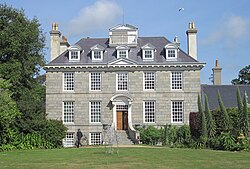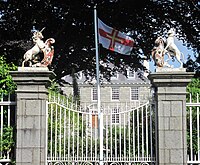Sausmarez Manor
| Sausmarez Manor | |
| Bailiwick of Guernsey | |
|---|---|
 Sausmarez Manor | |
| Location | |
| Location: | 49°26’10"N, 2°32’49"W |
| Village: | Saint Martin |
| History | |
| Built 12th to 19th centuries | |
| Manor house | |
| Queen Anne and various | |
| Information | |
| Owned by: | Peter de Sausmarez |
| Website: | sausmarezmanor.co.uk |
Sausmarez Manor is a historic house in the Parish of Saint Martin on Guernsey. This is a house of many ages: parts date from the early 13th or late 12th centuries, but it has been altered, reduced and added to over the years with major changes in Tudor, Queen Anne, Regency and Victorian times. The most impressive part is the front, regarded as the finest example of Queen Anne Colonial architecture in the British Isles, and which was built between 1714 and 1718 for Sir Edmund Andros, the 1st Governor of New York.
The estate was bought back into the de Sausmarez family in 1748, from the bounty which captain Philip de Sausmarez won in the capture of the Nusetra Senora da Capa Donga, the world's richest treasure ship.
Contents
The original manor house
The first mention of the Sausmarez family in Guernsey is at the consecration of the Vale church in 1117 attended by Guillaume de Sausmarez.[1] The family remained prominent in Guernsey throughout the Middle Ages, during which they acquired the manor which became known by their name.
Of this oldest manor-house only a fragment remains. Its rough but remarkably solid stonework forms the basis of an outhouse on the north-east side of the main buildings and surrounds an arched doorway which was later blocked in with a different form of stone. This is one of the most ancient fragments of unrepaired Norman masonry in the island and can be fairly confidently dated to the mid 13th century.
The Tudor house
Both manor and fief remained in the possession of the family until 1557. In that year the Seigneur of the manor, George de Sausmarez, died without issue and left his estate to his sister Judith; sixteen years previously she had married an Englishman called John Andrews. who had come to Guernsey from Northamptonshire as Lieutenant to Sir Peter Mewtis, the Governor of the Islands. Their son John, who became known in Guernsey as John Andros, was in 1557, in accordance with Guernsey law, declared Seigneur in his mother's right. His rights to the title and manor being confirmed by a Royal Commission that reported in 1607.[1] It was he who built the second house, running down the slope of the shallow valley towards the fish pond, at right angles to the original one. In a party-wall on the ground floor of this building there is carved, on a lintel over a door leading from the main-hall to a smaller room, the initials I.A. and the date 1585. The lower end of the house is now used as a craft metal workshop, and the upper, which was restored and altered, once in 1759 and again exactly two hundred years later, is still inhabited.
The Queen Anne house
Six members of the Andros family were Seigneurs of Sausmarez over a period of nearly two hundred years. The third of these, Amyas Andros, who was a staunch royalist throughout the Civil War, played a distinguished part as liaison between the King's forces which controlled Jersey and the brave royalist garrison of Castle Cornet. After the Restoration, he was made Bailiff of Guernsey by King Charles II, being one of the only two prominent Guernseymen who were not obliged to seek pardon from their Sovereign for their conduct during the 'Grand Rebellion', as the Civil War was known locally. His son, Sir Edmund Andros, was in 1674 both Bailiff and Lieutenant Governor of Guernsey and at the same time Governor of the Colony of New York as well as New England, North Carolina, Virginia, Massachusetts, New Plymouth and New Jersey. In fact it was he, who changed the name from New Amsterdam to New York, when he was its first British Governor. Very little of his time seems to have been spent in Guernsey, for he retired to live in Westminster. One of his reasons for doing so appears from the following clause in his will, dated 1713.
My will is that my said nephew, John, shall build within five years of my death a good suitable house on or at the manor of Sasmares in Guernsey and if the said John or his heirs shall not in that time have built such house (if not built before) then my will is and I appoint my said nephew John or his heirs to pay the sum of £500 unto my nephew George Andros within one year after his or their neglect.
Sir Edmund did not consider the old Tudor Manor House to be worthy of a man of his station. Moreover he contemplated rebuilding it himself. The great beauty of the building and the strong touches of New England influence that it displays indicate that the plans were prepared for him in London before his death in 1714. The work was duly carried out by John Andros during the next four years.
The façade, built of grey granite with red granite coigns is of beautiful proportions. The house, all the outer walls of which are two feet thick in thickness, is four storeys high and has two rooms on each floor. It originally had no communication with any of the earlier buildings. The main entrance is from a flight of eight steps leading to the oaken front door on the first floor. This door opens upon a hall whence a typical Queen Anne staircase rises to the top of the house, and ends with a door giving access to a widows walk, from which can be had a fine view of the greater part of the island.
The next Seigneur of the manor, Charles Andros, succeeded his uncle John in 1746. Within two years he had sold the house and fief back to the de Sausmarez family.
Philip de Sausmarez was the first of many of the family to serve in the Royal Navy: for George Anson's famed voyage around the world he served in HMS Centurion and was put in command of the Nusetra Senora da Capa Donga, a Spanish galleon captured during the voyage and which proved to be the richest prize ever taken.[1] He was killed in action and left a considerable fortune, derived from prize money, to his family. This windfall certainly helped John to buy back the fief and Manor House from Charles Andros in 1748.[1] (His nephew was Admiral James Saumarez, ennobled as the 1st Baron de Saumarez.)
Having regained the house of his ancestors John de Sausmarez celebrated his return by putting up the gates which are a well known feature of Sausmarez Road. Their outer pillars each bear the family crest of a falcon displayed, the two inner ones a unicorn and a greyhound, the supporters of the family arms. These were all the work of Sir Henry Cheere, the celebrated 18th-century sculptor who also made the memorial to Philip Saumarez in Westminster Abbey. In 1759 John restored the upper end of the Tudor manor house and added a new entrance to it.
The Regency house
John's heir, his eldest son Matthew, was Seigneur of the manor from 1774 to 1820. His main contribution to the estate was the building of the walls which enclose the potager, (vegetable garden) the orchard and the tennis court and the restoration of the old barn facing the Tudor house and to the south-west of it. When he died he was succeedeed by his brother Thomas who, like his father, was both Controller and Procureur, though for an even longer period of fifty-five years.
Thomas had been a fiery youth who, in 1790, had fought a successful duel against his cousin Robert le Marchant, a son of the bailiff of that day, the repercussions of which provoked considerable discussion in fashionable London circles. Thomas eventually settled down to have an enormous family. His two marriages brought him twenty-eight children. Though some of these died in infancy, he still had many who were not yet of age when he moved into the Manor. He therefore found the Andros house too small for his needs, and was obliged to build on to the back of it. His plans for it show it to have been a pleasant addition. It had a large breakfast room on the first floor and several bedrooms on this and the two upper floors. A central passage separated it on each floor from the Queen Anne house. On the ground floor, what is now part of a kitchen was originally used as the Procureur's office.
Little of this Regency house, which began in the last year of George III's reign, remains. Some of the doors and one of the bedroom windows are still clearly identifiable as is part of the roof. But the greater portion of it was pulled down by Thomas's youngest son, General George de Sausmarez who, having bought his brothers' shares of the property, became Seigneur and in 1873 began building the last and final additions to the family home with typical mid-Victorian gusto, employing a Parisian garden designer who had ambitious plans which would not be fulfilled.[2]
The Victorian house
General de Saumaurez had had a distinguished career in the service of the East India Company. An expert in small-arms training and a reformer in military administration he never saw a shot fired in war. In the Indian mutiny his, the Madras, command was the only one which had no mutineers. Yet though he won no great glory like Havelock and Colin Campbell, his was a lucrative post which enabled him on his return to Guernsey to indulge to the full his somewhat liberal and not always irreproachable taste.
Having pulled down most of his father's Regency house, General de Saumaurez replaced it on the first floor with a large dining-room and still larger drawing-room. Despite the unfortunate appearance which their windows and general design present from outside, in strong contrast to the Queen Anne facade, the interiors of these rooms have a peculiar charm. The same startling mixture of happy and unhappy touches of inspiration characterise the large entrance-hall which the General built on the north-east side of the Queen Anne house to link it with the Tudor one. The main feature of this hall and gallery is a riotous medley of wood-carving, some of it Burmese, some of it copies of the same by a local craftsman and some of it consisting of Old Testament figures and scenes, believed to have been acquired from Breton churches where they had been put up for sale.
Sir Havilland de Sausmarez had a distinguished judicial career in the service of the Foreign Office, including serving as Chief Judge of the British Supreme Court for China for 16 years and later became Bailiff of Guernsey. Sir Havilland died during the German occupation of the Island. His persistent refusal to install electric light saved the manor from being requisitioned by the occupying power. His nephew, the late Seigneur, Cecil de Sausmarez, after a distinguished career in the Diplomatic Service and whilst a successful people deputy carried out an extensive programme of restoration and modernisation of the property.
Outside links
References
- ↑ 1.0 1.1 1.2 1.3 Jacob, John. Annals of Some of the British Norman Isles Constituting the Bailiwick of Guernsey: As Collected from Private Manuscripts, Public Documents and Former Historians. author, 1830.
- ↑ "The head guide at Sausmarez Manor took us on a tour of its gardens". BBC. http://www.bbc.co.uk/guernsey/content/articles/2009/03/13/sausmarez_manorgardens_feature.shtml.
